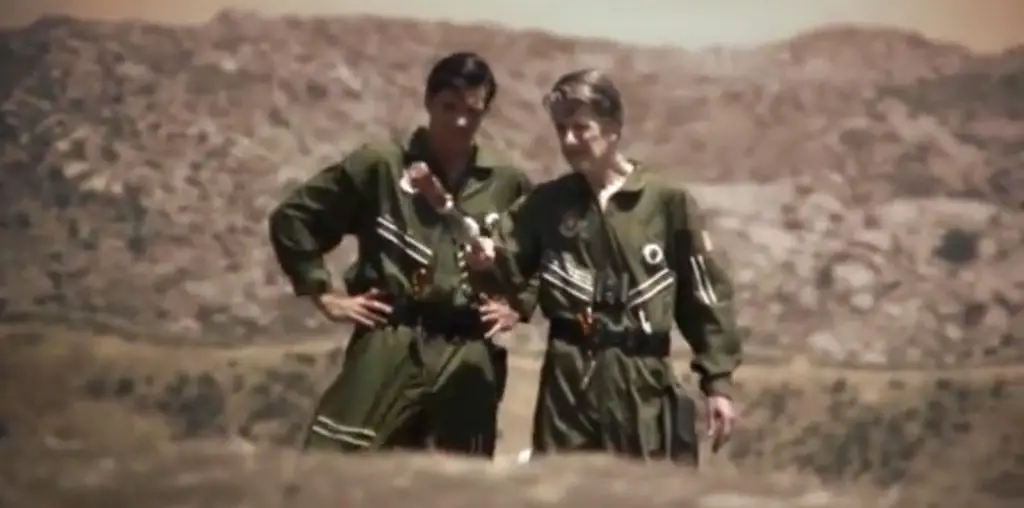
Was Open Water you first film? ^ LL: No, this was our second film. We had a film that was released in 1997 called “Grind,” which starred Billy Crudup and Amanda Peet. It was the first film for both of them, also. That was shot in 35 millimeter with a full crew, and a much bigger production than this one. There’s another “Grind” (Casey La Scala’s 2003 teen skateboarding film) that came out more recently. That’s not the one we made. Ours is about two brothers living in New Jersey. It was released in LA and New York theatrically, and you can get it on DVD and video. It played on cable. It was our first film. There are elements about that film that we’re proud of. I think that Chris and I were also learning how to collaborate. We wrote that script together.
CK: It was more traditional in terms of shooting with a crew and 35 millimeter, but still low budget.
When you pitched Open Water to potential backers… ^ CK: We never pitched it. We had always intended to finance it ourselves. We set out to make a feature, broke the script down, and figured out how much it would cost. That’s how we determined the budget. Entirely self-financed. The inspiration for the film was this technological revolution – this incredible equipment that’s available and affordable. Lightweight cameras that are in reach of everybody. Then you look at the success of the Dogme 95 films. It’s exciting. You can have complete control, and focus on exactly what it is that you want to say. You take two unknown actors, throw them into the ocean, and ask the audience to watch them for an hour and a half. We knew this would be a challenge – to keep people engaged.
How much of the film was thought out and scripted, and how much was improvised during filming? ^ CK: The majority of it was part of the structure of the script, plus a lot of research based on our own experiences as divers.
LL: There was no improvisation. The film was entirely scripted. However, there’s no question that during production and post-production ideas came that were not in the original script.
CK: We tried to be open to what presented itself. For instance, the lightning scene. It was always scripted that we were gonna have that night scene, where they’re shivering and praying, with sharks bumping into them. But one night, a lightning storm broke out, and I shot it – not really knowing what I was going to use it for, until I got into the editing room.
LL: There were several shoots. Chris was working the whole time, so we shot on weekends, and during vacations. We shot six weeks in total. Out of those six weeks, there were only two days in which we actually worked with the sharks. The actors – for safety reasons – really couldn’t do a lot. They couldn’t make a lot of noise or splash around.
CK: They would sit there with their eyes bulging (laughter)…
LL: They had to keep their arms in, and had chain mail on. Really, the bulk of their performances was shot long after. Months later, with no sharks in the water.
For the uninformed, explain the concept of chain mail. ^ CK: Chain mail is a mesh suit made of links. Metal mesh. When a shark bites down, it’s unable to penetrate the chain. Not only that, but the shark lets go. It was an important thing to have, safety-wise. I didn’t wear the chain mail. We were in really good hands. We worked with the best shark people in the world, including Stuart Cove. We weren’t worried about budget, when it came to safety with the sharks. And they work with these sharks on a daily basis, the way they have for years. They know exactly how to read the sharks’ behavior. The gray reef shark, which was used, is considered one of the more dangerous species. If I ran into the gray reef shark out in the wild, I wouldn’t want to be in the water…
LL: But this particular shark population is used to being around divers, and has been for about fifteen years. Boats take divers out there every day, and the sharks have been filmed by photographers. On the other hand, the other film productions they’ve done were under the water. A lot of our shoots were from the perspective of the characters. We were shooting from the surface, which is not the usual way of working with the sharks.
When a dorsal fin cuts the surface in Open Water, it’s kind of a chaotic, quick swipe. There isn’t the deliberate, smooth fin that you see in other shark movies. ^ CK: That’s exactly what we were looking for. Chaotic is a great word to describe it.
LL: Exactly right!
Would you say “Jacques Cousteau meets Tobe Hooper” is an apt description of Open Water? ^ LL: We wanted to portray the sharks in a way they had not been portrayed in the movies before. In most shark movies, there’s a shark in the water, then someone falls in, and the shark rips them up. In our movie, there was a lot of research done on the actual behavior of sharks. We wanted to portray them as an animal, just as man is an animal, in the ecosystem. I like the Jacques Cousteau comparison, because we really did study the behavior of sharks…
CK: I did a great deal of research on shark attacks, and every one of them was a case of mistaken identity, or curiosity, on the part of the shark. We really wanted to get the behavior right.
Get the rest of the interview in part three of BIG FISH: CHRIS KENTIS & LAURA LAU ON “OPEN WATER”>>>
